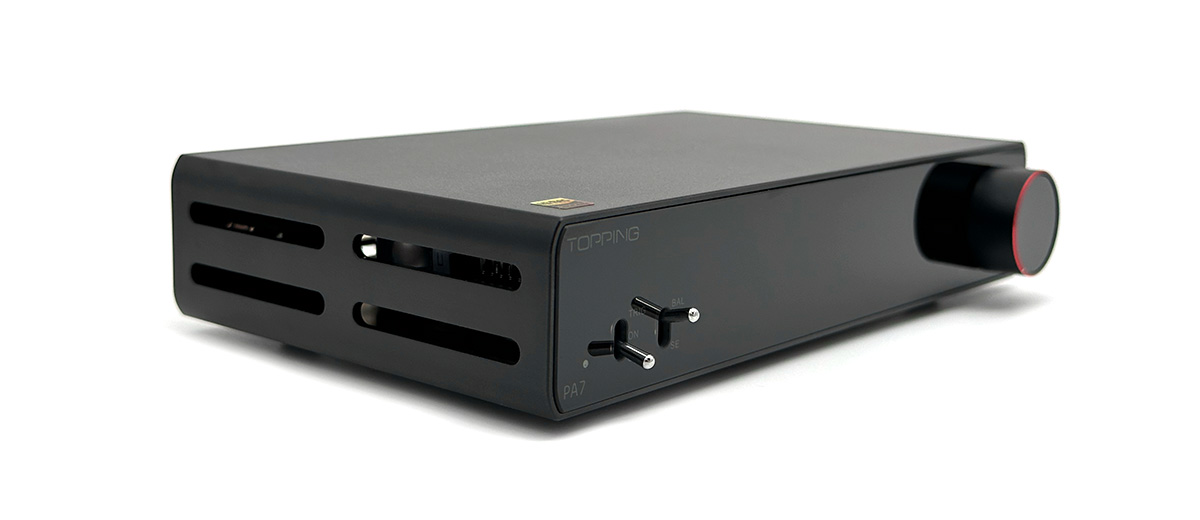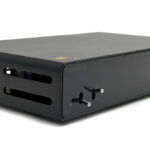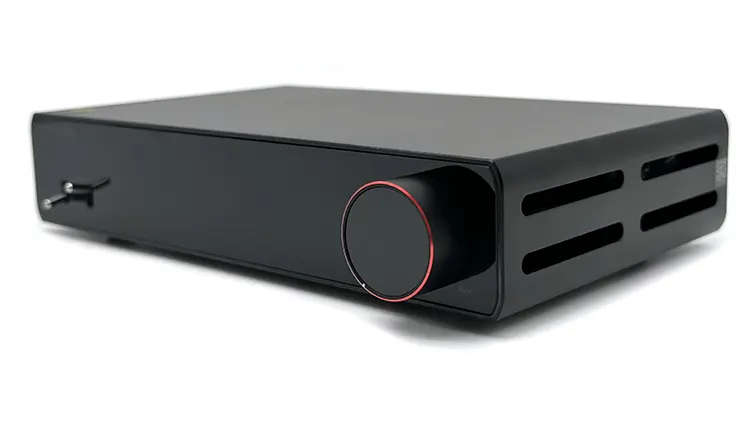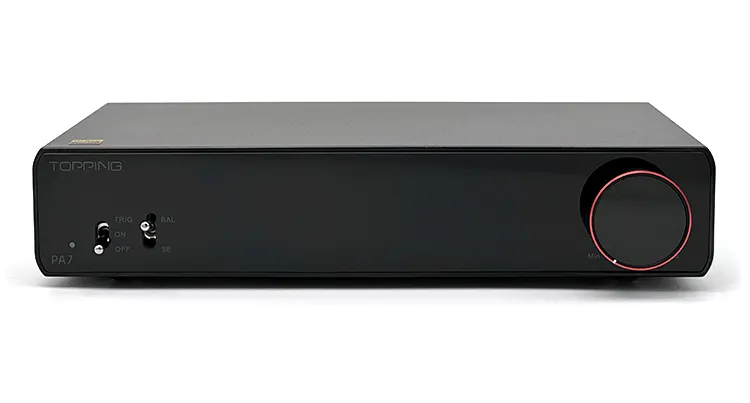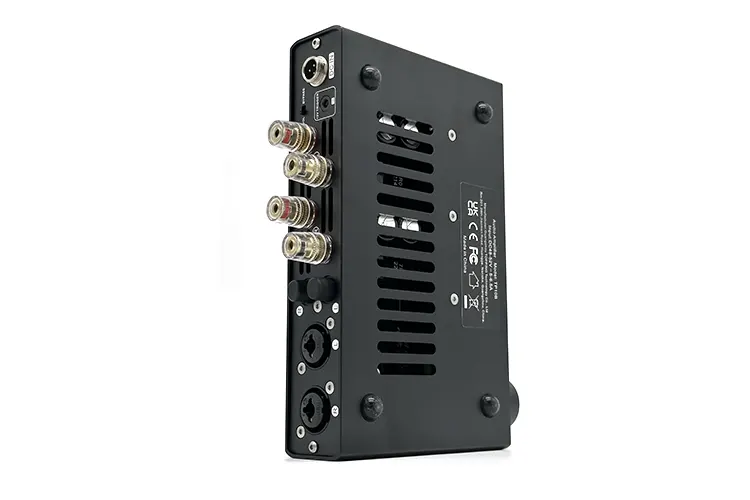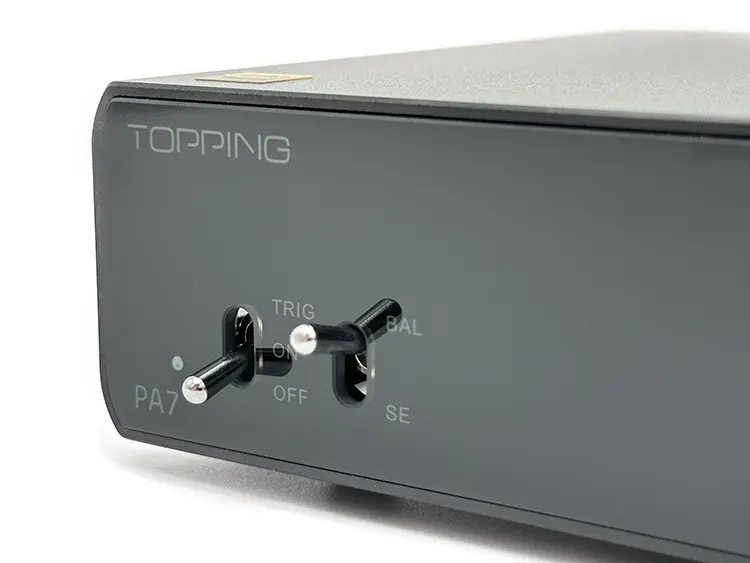In this feature, we review the Topping PA7, which is a fully-balanced desktop power amplifier capable of delivering 210W x 2 into a 4Ω speaker load. It is priced at $449.00.
Disclaimer: This sample unit was sent to us in exchange for our honest opinion. We thank the team at Shenzhen Audio and Topping for giving us their support.
Click here to read more about Topping products that we have previously assessed on Headfonics.
Note, that this article follows our current scoring guidelines which you can read here.
Among the series of DACs and amplifiers Topping has recently announced is a $799 discrete power amplifier that honestly got my wallet frightened a little bit.
Received positively, the LA90 Discrete is a reminder that the Chinese manufacturer is also seriously thinking about their home audio fans. Still, it is quite a diversion to their more established lineup of Infineon-based Class-D speaker amplifiers.
The Topping PA7 and the PA7 Plus are more of a nod back to the PA3 and PA5 that came before it. I owned the pocket-sized PA3 before and the compact unit served me well in a nearfield setup. This is the beauty of a chip-based design since it is not impossible to pack a punch in a pint-sized chassis.
The key difference between the PA7 and the PA7 Plus can be answered by how much power your equipment requires. The PA7 we reviewed here is the less commanding of the two but you’ll see in a minute how easily it can already handle most speakers out there.
Tech Highlights
The PA7 in my opinion was released quite discreetly. I didn’t see online campaigns as much as with the LA90 Discrete. Maybe they think the audience for a Class-D power amplifier is less, but the PA7 will surely not disappoint those who will bother to glance.
I can only guess that there is an Infineon chip inside similar to what the PA3 and PA5 have although there is no clear mention of this anywhere in the product writeup. Instead, attention is being drawn toward the fully balanced circuitry that not only helps reduce noise but also carries a ton of power for its size.
Rated for both 4Ω and 8Ω loads, the PA7 will pair easily with most passive speakers. Even less efficient units won’t be too much of a problem since the output coming from the binding posts on the rear can go up to 210W measured at THD+N<10%. For those curious, the ‘Plus’ is at 300W of maximum output power.
Historically for Topping, 210W is a milestone since the slightly lower tier PA5 taps out at 140W and even their more premium LA90 Discrete is only pushing 120W on stereo mode.
Having a Bridge-Tied Load (BTL) output helps achieve this feat which in simple terms means that there are two amplifiers generating power per speaker.
Design
Just look at the PA5 or the E70 and you’ll immediately notice some familiar cues. But since the PA7 doesn’t sport a display and touch controls like the E70 even though its platform is established to stack on top of it, its smaller brother still proves it is closer relatively.
The cutout on the sides previously seen in the PA5 has been copied to be at the front half of the case as well. This allows even greater access to looking at what’s inside where the PCB can be seen dangling invertedly as it is screwed on the ceiling.
In front, the wide glass panel adds flare but some might see it as bare. There are only the switches on the left and the volume wheel on the right to break the stillness, therefore, acting as the main design.
It gets a bit interesting towards the rear. With XLR/TRS balanced inputs, Topping is not gatekeeping users of PA7 to get the XLR-capable E70. But to those that will, it is pleasant to see that the inputs and outputs of the two devices are aligned for easy cable management.
I/O
It’s not every day that a 3-pin type DC inlet is fitted to a consumer-grade device since most only require 5V-24V to run.
Reading the spec sheet of the PA7 though, the power it puts out is surely drawn from somewhere, and that somewhere is from its beefy 48V/5A power supply. Get the PA7 Plus and that goes up to 52V/6.5A of DC input requirement.
Another cool feature the PA7 has that will likely go unnoticed by most is the trigger input. The 3.5mm connection allows seamless integration like the E70 which as expected has a trigger output.
There are two main analog inputs available behind the PA7, a single-ended pair of RCA jacks and a pair of REAN-branded XLR/TRS connectors.
What is interesting here is that Topping increased pairing options with TRS-capable sources instead of 4.4mm. Maybe in the world of home audio, 4.4mm cables are still less popular.
The output terminals of the PA7 accept most types of speaker cable connectors from banana type to even bare wire. The binding posts are also suitably sized and feel solid when linking with my speaker cables.
Control
Limited as the PA7 may be in features as it stays true to its purpose of being a trusty device in delivering loads of power to passive speakers, the simplicity makes it feel familiar quite easily. With only four things to set, even less after the initial operation, the PA7 joins the list of user-friendly units.
To reduce complexity for systems with multiple volume control like when the PA7, E70, and L70 get stacked together, the volume knob can be turned off utilizing a switch located in the rear.
I know that there is a debate as to where the volume should be controlled, but one application I see is when using a preamp with a remote for far-field listening.
To power the unit and select between the two inputs, one only need to turn their attention to the straightforward pair of toggle switches on the left of the PA7.
Putting more attention to the leftmost control, the PA7 is equipped with a 12V trigger input so flipping it to its highest position will allow synced initialization with connected devices.
Packaging & Accessories
The PA7 arrived on my doorstep before I could check out more details about this new power amplifier from Topping. And as with all things heavy and big, I expected the good-sized retail box to be because of the unit itself.
The PA7 only uses half the packaging space with the rest taken up by a bullish-looking 48V Topping power brick. Removing the cover, the power supply is seen turned sideways not protected by foam on one side probably to save a bit on height.
Aside from some paper works, the only thing left to take out of the box is a power cable that connects to the power supply increasing the total length. The cable is two-pronged with no pin for the ground.
Sound Impressions
The sound impressions were completed by pairing the PA7 with a Chord Electronics Qutest DAC and a pair of Monitor Audio Silver 50 passive bookshelf speakers.
Timbre
Having hooked my speakers to a warmer amplifier for a couple of years now, the switch to the PA7 breathed new life into it.
I wouldn’t call it as sparkling or anemic since Topping figured to leave a bit of friendliness in its attack. More importantly, its image tightness is what impressed me as the whole scene stayed crisp and accurate even when playing loud.
With a permanent tuning out of the box, the low-end needs to perform. While the bite could use a bit more sensitivity to broader strokes, lingering reverb from drums is supported with depth and satisfying dispersion.
Again, there are warmer amps out there with more vigorous punch and elevation but listening to simpler pluck of a bass guitar shows that there is a bit of girth and wetness on tap. Sacrificing some clarity with engagement and life, the PA7 has enough juice to spice up the sound.
The next thing that jumped out to me is the vocal region as the PA7 cleanly isolated center images while emanating honesty in timbre. I’d like to compare it with a light sauce reduced down to the portions that matter. It can get a bit lenient though with handling poorly recorded songs.
The precision though could leave those looking for a sweeter sound a bit unsatisfied unless used to pair with a warmer source. But whenever I get the urge to play the PA7 loud, the reverb and airiness help to add some dimensionality to both singers and instruments.
The treble region is good. The control here is superb instead of loading the performance with harshness. The PA7 won’t shout unnecessarily, but only when the song dictates does it free itself a bit.
Staging & Dynamics
Taking its timbre and tonal balance as an advantage, the PA7 sound stage is not overly stretched, sounding agile and unrestricted. The lean and tight image enables quick work with locating and placing an instrument.
Electric guitar riffs play with even height and energy with vocals. It layers pretty well as it gives way to the main man singing in front to do his thing while it stays happily in a clear line just a step behind.
With a live audience, I don’t get too much compression with the reenactment of different layers. When clapping started, the PA7 filled the room with dynamic energy giving each individual their personality for quite a realistic sound.
The PA7 uses the full width of the stage, filling it evenly with images. The frontal depth between a male and female vocalist singing a duet is uniform with just a bit of bias pushing colder singers further.
Click on page 2 below for our suggested pairings and select comparisons.

